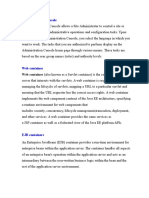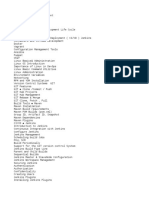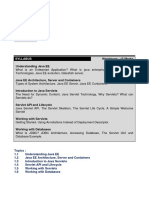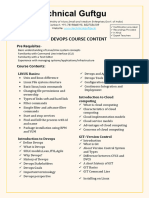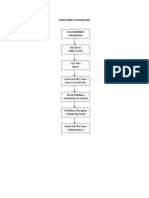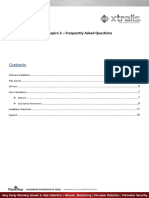Oracle Weblogic Server 11g Admin Essentials
Uploaded by
SureshOracle Weblogic Server 11g Admin Essentials
Uploaded by
SureshOracle WebLogic Server 11g: Administration Essentials
Duration: 5 Days Course Code: D58682GC21
Overview:
This Oracle WebLogic Server 11g: Administration Essentials training teaches Web administrators techniques for installing and configuring
Oracle WebLogic Server 11g. Expert Oracle University instructors will teach you how to deploy Java EE applications to Oracle WebLogic
Server 11g using Administration Console and command-line and scripting tools like WLST.
Benefits to You
Increase the performance and scalability of your organization’s applications and services with the #1 application server. Simplify deployment
and significantly improve time-to-market.
Configure Oracle HTTP Server
You'll also learn to configure Oracle HTTP Server as the Web interface for Oracle WebLogic Server, along with supporting failover and load
balancing for applications.
Overview of Administrative Tasks
This course provides an overview of the administrative tasks performed by a WebLogic Server administrator. At the end of the course, you will
have gained knowledge at an associate level of competency.
Appendix
An appendix is included covering the differences between the 11g (10.3.3) and 12c (12.1.1) product versions with regard to Oracle WebLogic
Server administration topics.
The follow up Oracle WebLogic Server 11g: Advanced Administration course provides a more in depth coverage of administration tasks.This
course is an upgrade of Oracle WebLogic Server 10g R3: System Administration.
Target Audience:
Webadministrator
Objectives:
Monitor application server using GUI and command-line tools Configure Oracle HTTP Server as the Web-tier front end for Oracle
such as automation scripts WebLogic Server instances and clusters
Describe the architecture of WebLogic Server including domains, Deploy different types of Java EE applications to Oracle WebLogic
servers and machines Server
Install, configure and use WebLogic Server Deploy and manage large-scale Java EE applications to servers or
clusters through the entire development and production lifecycle
Perform routine Oracle WebLogic Server administration functions
Configure basic resource and application security
Set up a cluster of servers and distribute applications and
resources to the cluster Backup and recover from various failures
Prerequisites:
Required Prerequisites:
Basic TCP/IP networking knowledge of client/server concepts
Basic Linux commands and desktop navigation
Suggested Prerequisites:
Basic Java EE concepts and constructs including Servlet, JSP
Recommended Related Training Courses:
Oracle WebLogic Server 11g: Advanced AdministrationThis
Weblogic Server 11g training teaches experienced WebLogic
Server administrators advanced techniques to manage, monitor,
troubleshoot & optimize application server environments. Learn to
use advanced messaging, security & clustering features.
D58682GC21 www.globalknowledge.com/en-sa/ training@globalknowledge.com.sa 00 966 92000 9278
Oracle SOA Suite 11g: Essential ConceptsThis SOA Suite 11g
training introduces you to fundamental information and technical
understanding of SOA concepts and Oracle SOA Suite product.
Learn how composite applications are built and managed on the
Oracle SOA platform.
Oracle Service Bus 11g: System AdministrationThis course
enables you to install, configure, administer, and secure Oracle
Service Bus (OSB) 11g product. It provides you with a hands-on
experience in administrating its different components by using the
Service Bus Console, WLST, and WebLogic Server Administration
console.
Oracle WebLogic Server 11g: Diagnostics and
TroubleshootingThis course trains experienced Oracle WebLogic
Server administrators on the methodologies and tools for
troubleshooting common technical issues found in the application
server environment. Students build upon their fundamental
WebLogic knowledge to identify the symptoms of typical problems
as well as the techniques for identifying their causes.
Oracle WebLogic Server 11g: Monitor and Tune PerformanceThis
Oracle WebLogic Server 11g: Monitor and Tune Performance
training teaches Oracle WebLogic Server administrators and
architects to tune various subsystems of Oracle WebLogic Server
for optimal performance. Monitor & perform load tests to evaluate
performance.
D58682GC21 www.globalknowledge.com/en-sa/ training@globalknowledge.com.sa 00 966 92000 9278
Content:
Introducing Oracle Fusion Middleware Platform Configuring Node Managers Introduction to Clustering
line line line
Describing the Oracle Fusion Middleware Defining the Oracle WebLogic Server The Benefits of Oracle WebLogic Cluster
Environment Machine Basic Cluster Architecture
Describing How WebLogic Server Supports Configuring a Machine and Assign Multitier Cluster Architecture
Various Fusion Middleware Suites Servers to it by Using the Console and Communication Among Clustered Server
Describing How Various Fusion Middleware WebLogic Scripting Tool (WLST) Instances
Suites Augment the Functions of WebLogic Explaining the Node Manager The Key Criteria for Selecting Suitable
Server Architecture Cluster Architecture
Describing the Organization and
Defining Java Enterprise Edition Terminology Contents of a Node Manager Directory Configuring a Cluster
and Architecture Structure line
line Configuring, Starting, and Stopping Node Preparing Your Environment for a Cluster
Explaining the Motivation Behind Distributed Managers Creating and Configuring a Cluster
Systems Describing How to Start and Stop Adding Servers to a Cluster
The Major Components of the Java Platform Procedures Starting Up and Shutting Down Clustered
Enterprise Edition 5 (Java EE) Specification Servers
Viewing and Managing Logs in Oracle WLS
Installing Oracle WebLogic Server Environment Managing Clusters
line line line
Explaining Oracle WebLogic Server Defining and Configuring Server and Deploying Applications to a Cluster
Installation Steps Domain Logs Describing the Replication of a Session
Installing WebLogic Server Using Both the Viewing and Interpreting the Format of State in a Cluster
Graphical User Interface (GUI) and Domain and Server Log Files Using the Configuring Replication Groups
Command Line Administration Console Configuring In-memory Replication
Describing the Organization and Contents of Configuring Server Standard Output Configuring Java Database Connectivity
the WebLogic Server Directory Structure Settings Using the Console (JDBC) Replication
Navigating the WebLogic Server Online and Describing How Applications Can Configuring File Replication
Offline Documentation Integrate With WLS Logging Configuring a Multitier Cluster for
Infrastructure (Apache commons, log4j) Enterprise JavaBeans (EJB) Applications
Configuring a Simple Domain Accessing Online Log Message Catalogs
line Creating and Applying a Log Filter Using Security Concepts and Configuration
Describing the Common Elements in a the Console line
WebLogic Server Domain Configuring Log Filter Expressions Using the WebLogic Server (WLS)
Describing how Domains are Used in the Security Architecture
Enterprise Deployment Concepts Configuring Security Realms
Comparing Administration and Managed line Configuring Users and Groups
Servers Contrasting Autodeploy With Manual Configuring Roles
Configuring a Domain Deployment Configuring Policies
Describing the Organization and Contents of Configuring and Deploying Web Configuring Protection for Web Application
the WLS Directory Structure Applications Via the Administration Resources and EJBs
Describing the use of WLST Offline to Console, Command Line, and WLST
Manage Domains Configuring Deployment Descriptors Protecting Against Attacks
Creating a Simple Domain with One Testing Deployed Applications line
Managed Server Describing the Role of Web Servers Describing the Process of Configuring
Checking the Port Numbers that are Used Tracing a Typical Web Interaction Flow Secure Sockets Layer (SSL)
for Components Contrasting Static and Dynamic Content Using the Keytool Utility to Configure Keys
and Deployment and Obtain Digital Certificates
Configuring a Domain Using Templates Front-end Deployed Applications With a Configuring SSL for the WLS Server
line Web Server Configuring Countermeasures for Some
Describing the Internal Process Used to Web-based Attacks
Create or Update a Domain Using a Deploying Java EE Applications
Template line Backup and Recovery Operations
Describing the Process of Extending a Describing Java EE Web Applications line
Domain Template Describing Enterprise Deployment Recommending a Backup and Recovery
Explaining the Domain Templates Provided Architectures Strategy
for Setting up JDeveloper, SOA, and Packaging Web Applications in Several Performing a Full Offline Backup and
WebCenter Forms Recovery
Defining Web Application Structure and Performing an Online and Offline Domain
Using Administration Console and WLST Web Application Archive Backup
line Explaining Why WebLogic Augments Performing an Offline Domain Recovery
Identifying Dynamic and Nondynamic Standard Java EE Deployment Performing an Instance Home Backup and
Attribute Changes in the Administration Descriptors With weblogic*.xml Files Recovery
Console Looking at Deployment Descriptors
D58682GC21 www.globalknowledge.com/en-sa/ training@globalknowledge.com.sa 00 966 92000 9278
Customizing Monitoring Tables Within the web.xml and weblogic.xml
Administration Console Describing URLs and Web Applications
Using the WebLogic Scripting Tool (WLST)
Command-line Utility Advanced Deployment
Invoking WLST and Navigate Through the line
Domain Structure Configuring an Application for Multiple
Describing How Change Management is Development Environments
Performed Internally Using Java Creating a Deployment Plan
Management Extension (JMX) and Mbeans Staging a Deployment Plan
Using Production Redeployment
Configuring Managed Servers
line Understanding JDBC and Configuring Data
Configuring Managed Servers Using the Sources
Administrative Console line
Configuring Managed Servers Using Configuring JDBC and JDBC Data
WebLogic Scripting Tool (WLST) Sources
Starting Managed Servers Configuring Data Source Scope
Shutting Down a Server or an Entire Domain Contrasting Two-tier and Multi-tier JDBC
Using WLST or the Administrative Console Architecture
Configuring Managed Servers on a Configuring a Connection Pool
Computer Separate from the Sdministration Describing How Data Sources are Used
Server Deploying JDBC Resources to a Target
Explaining Administration and Managed Explaining the Components of JDBC
Server Independence (MSI) URLs
Monitoring and Testing a Data Source
Setting Up Java Message Service (JMS)
Resources
line
Describing JMS
Describing How Oracle WebLogic Server
JMS is Implemented
Configuring JMS Server
Configuring Connection Factories
Configuring Queues and Topics
Configuring Persistent Messages
Deploying an Application that Uses JMS
Monitoring JMS Resources and
Messages
Further Information:
For More information, or to book your course, please call us on 00 966 92000 9278
training@globalknowledge.com.sa
www.globalknowledge.com/en-sa/
Global Knowledge - KSA, 393 Al-Uroubah Road, Al Worood, Riyadh 3140, Saudi Arabia
D58682GC21 www.globalknowledge.com/en-sa/ training@globalknowledge.com.sa 00 966 92000 9278
You might also like
- Oracle Fusion Middleware Interview Questions: Edition100% (1)Oracle Fusion Middleware Interview Questions: Edition16 pages
- WebLogic Server Besant Technologies Course SyllabusNo ratings yetWebLogic Server Besant Technologies Course Syllabus5 pages
- Weblogic Administration in Linux&SolarisNo ratings yetWeblogic Administration in Linux&Solaris3 pages
- Oracle WebLogic Server 12c Performance Tuning WorkshopNo ratings yetOracle WebLogic Server 12c Performance Tuning Workshop3 pages
- Management Studio: Hanoi University of TechnologyNo ratings yetManagement Studio: Hanoi University of Technology25 pages
- Unit 4 Advance Java: Structure Page NosNo ratings yetUnit 4 Advance Java: Structure Page Nos22 pages
- Oracle® Fusion Middleware: Introducing Web Services 11g Release 1 (11.1.1)No ratings yetOracle® Fusion Middleware: Introducing Web Services 11g Release 1 (11.1.1)16 pages
- ARREAR Updated FSWD Ans Key 26.06.2023- CopyNo ratings yetARREAR Updated FSWD Ans Key 26.06.2023- Copy12 pages
- Administration Console: Web Container (Also Known As A Servlet Container) Is The Component of A WebNo ratings yetAdministration Console: Web Container (Also Known As A Servlet Container) Is The Component of A Web4 pages
- Product - Middleware - Oracle SOA Suite 12c - System Architecture and Administration100% (1)Product - Middleware - Oracle SOA Suite 12c - System Architecture and Administration12 pages
- Course Contents: Introduction To SQL Server 2008 Administration Welcome To SQL Server 2008No ratings yetCourse Contents: Introduction To SQL Server 2008 Administration Welcome To SQL Server 20085 pages
- Science Bsc-Information-Technology Semester-5 2018 November Enterprise-Java-CbcsNo ratings yetScience Bsc-Information-Technology Semester-5 2018 November Enterprise-Java-Cbcs31 pages
- Getting Started with Oracle WebLogic Server 12c: Developer’s GuideFrom EverandGetting Started with Oracle WebLogic Server 12c: Developer’s GuideNo ratings yet
- What Is A Domain? Organizing Domains Contents of A Domain Domain Restrictions Domain ModesNo ratings yetWhat Is A Domain? Organizing Domains Contents of A Domain Domain Restrictions Domain Modes18 pages
- Ava Ull Tack Ontent - Ays: Advanced Java/ J2EE JDBCNo ratings yetAva Ull Tack Ontent - Ays: Advanced Java/ J2EE JDBC7 pages
- Weblogic Interview Questions - 1: Provide The Wizard StartupNo ratings yetWeblogic Interview Questions - 1: Provide The Wizard Startup3 pages
- Oracle OAF Introduction - by Dinesh Kumar SNo ratings yetOracle OAF Introduction - by Dinesh Kumar S163 pages
- IBM Websphere Application Server Admin Course ContentNo ratings yetIBM Websphere Application Server Admin Course Content4 pages
- Download Full Core Servlets and JavaServer Pages Vol 1 Core Technologies 2. ed., Nachdr Edition Hall PDF All Chapters100% (5)Download Full Core Servlets and JavaServer Pages Vol 1 Core Technologies 2. ed., Nachdr Edition Hall PDF All Chapters54 pages
- WildFly Configuration, Deployment, and Administration - Second EditionFrom EverandWildFly Configuration, Deployment, and Administration - Second EditionNo ratings yet
- SQL Server Mastery: Advanced Techniques for Database Optimization and AdministrationFrom EverandSQL Server Mastery: Advanced Techniques for Database Optimization and AdministrationNo ratings yet
- Mastering Java: A Comprehensive Guide to Programming Excellence CategoryFrom EverandMastering Java: A Comprehensive Guide to Programming Excellence CategoryNo ratings yet
- Job Responsibilities and Skills Required - Versa ExperienceNo ratings yetJob Responsibilities and Skills Required - Versa Experience2 pages
- Paper Overview Nonlinear MPC ApplicationsNo ratings yetPaper Overview Nonlinear MPC Applications24 pages
- CT3223-07 New Brilliance 64-channel DMS Module ClassificationNo ratings yetCT3223-07 New Brilliance 64-channel DMS Module Classification4 pages
- Dynamic Equivalents in Power System Studies A ReviNo ratings yetDynamic Equivalents in Power System Studies A Revi15 pages
- Mathematics 216 Carrousel 2:: Itinerary 5No ratings yetMathematics 216 Carrousel 2:: Itinerary 52 pages
- Android Application To Convert Speech To Text andNo ratings yetAndroid Application To Convert Speech To Text and5 pages
- Et200sp - DQ - 4x24vdc - 6ES7 132-4BDO20AA0No ratings yetEt200sp - DQ - 4x24vdc - 6ES7 132-4BDO20AA026 pages
- Wiley - Fundamentals of Microelectronics, 2nd Edition - 978-1-118-15632-2No ratings yetWiley - Fundamentals of Microelectronics, 2nd Edition - 978-1-118-15632-23 pages
- Math Lessons: Presented By: Shea Iris C. SamonteNo ratings yetMath Lessons: Presented By: Shea Iris C. Samonte18 pages
- Instructions - Fortigate Cli Reference Mr6100% (5)Instructions - Fortigate Cli Reference Mr614 pages
- 2-Storey With Roof Deck Apartment BuildingNo ratings yet2-Storey With Roof Deck Apartment Building4 pages
- Access Control Lists: CCNA Routing and Switching Connecting Networks v6.0No ratings yetAccess Control Lists: CCNA Routing and Switching Connecting Networks v6.045 pages
- Oracle Fusion Middleware Interview Questions: EditionOracle Fusion Middleware Interview Questions: Edition
- WebLogic Server Besant Technologies Course SyllabusWebLogic Server Besant Technologies Course Syllabus
- Oracle WebLogic Server 12c Performance Tuning WorkshopOracle WebLogic Server 12c Performance Tuning Workshop
- Oracle SOA Suite 11g Administrator's HandbookFrom EverandOracle SOA Suite 11g Administrator's Handbook
- Oracle® Fusion Middleware: Introducing Web Services 11g Release 1 (11.1.1)Oracle® Fusion Middleware: Introducing Web Services 11g Release 1 (11.1.1)
- Administration Console: Web Container (Also Known As A Servlet Container) Is The Component of A WebAdministration Console: Web Container (Also Known As A Servlet Container) Is The Component of A Web
- Product - Middleware - Oracle SOA Suite 12c - System Architecture and AdministrationProduct - Middleware - Oracle SOA Suite 12c - System Architecture and Administration
- Course Contents: Introduction To SQL Server 2008 Administration Welcome To SQL Server 2008Course Contents: Introduction To SQL Server 2008 Administration Welcome To SQL Server 2008
- Science Bsc-Information-Technology Semester-5 2018 November Enterprise-Java-CbcsScience Bsc-Information-Technology Semester-5 2018 November Enterprise-Java-Cbcs
- Getting Started with Oracle WebLogic Server 12c: Developer’s GuideFrom EverandGetting Started with Oracle WebLogic Server 12c: Developer’s Guide
- What Is A Domain? Organizing Domains Contents of A Domain Domain Restrictions Domain ModesWhat Is A Domain? Organizing Domains Contents of A Domain Domain Restrictions Domain Modes
- Ava Ull Tack Ontent - Ays: Advanced Java/ J2EE JDBCAva Ull Tack Ontent - Ays: Advanced Java/ J2EE JDBC
- Weblogic Interview Questions - 1: Provide The Wizard StartupWeblogic Interview Questions - 1: Provide The Wizard Startup
- IBM Websphere Application Server Admin Course ContentIBM Websphere Application Server Admin Course Content
- Download Full Core Servlets and JavaServer Pages Vol 1 Core Technologies 2. ed., Nachdr Edition Hall PDF All ChaptersDownload Full Core Servlets and JavaServer Pages Vol 1 Core Technologies 2. ed., Nachdr Edition Hall PDF All Chapters
- IBM WebSphere Application Server 8.0 Administration GuideFrom EverandIBM WebSphere Application Server 8.0 Administration Guide
- WildFly Configuration, Deployment, and Administration - Second EditionFrom EverandWildFly Configuration, Deployment, and Administration - Second Edition
- SQL Server Mastery: Advanced Techniques for Database Optimization and AdministrationFrom EverandSQL Server Mastery: Advanced Techniques for Database Optimization and Administration
- Mastering Java: A Comprehensive Guide to Programming Excellence CategoryFrom EverandMastering Java: A Comprehensive Guide to Programming Excellence Category
- Job Responsibilities and Skills Required - Versa ExperienceJob Responsibilities and Skills Required - Versa Experience
- CT3223-07 New Brilliance 64-channel DMS Module ClassificationCT3223-07 New Brilliance 64-channel DMS Module Classification
- Dynamic Equivalents in Power System Studies A ReviDynamic Equivalents in Power System Studies A Revi
- Wiley - Fundamentals of Microelectronics, 2nd Edition - 978-1-118-15632-2Wiley - Fundamentals of Microelectronics, 2nd Edition - 978-1-118-15632-2
- Access Control Lists: CCNA Routing and Switching Connecting Networks v6.0Access Control Lists: CCNA Routing and Switching Connecting Networks v6.0





















